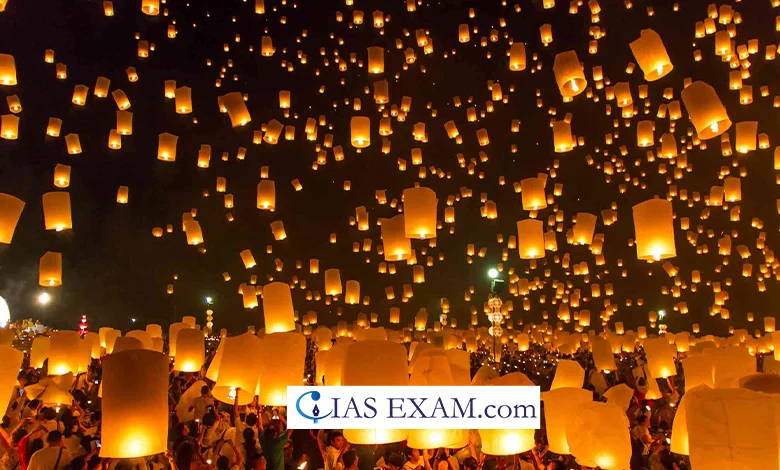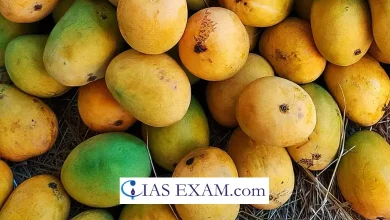India’s Traditional New Year Festivals
Syllabus: History [GS Paper-1]

Context
The President of India, Smt. Droupadi Murmu sent greetings on the occasions of Vaisakhi, Vishu, Pana Sankranti, Bohag Bihu, Pohela Boishakh, Vaishakhadi, and Puthandu.
More on News
- On the eve of the auspicious occasions of Vaisakhi, Vishu, Bishub, Bahag Bihu, Poila Baisakh, Vaishakhadi, and Puthandu, the President of India, Shreemati, called for the attention of the nation to renew their faith. The President Droupadi Murmu wished all the Indians, wherever they are staying in the country and overseas, a long, joyful life and a successful year.
- The President’s message brought into focus the bright colours of the festivals and these as indispensable icons of India’s diverse cultural legacy and also symbols of unity, understanding, and solidarity.
- These holidays, which are celebrated widely in different regions, are generally treated as agents of refreshing the spirit, as it awakens new dreams in people’s lives.
- Along with this, they stand for paying tribute to farmers who are the backbone of the country and who always work hard to give everything to Indian soils.
Details about the Festivals
- India celebrates several traditional New Year festivals, each with its own cultural significance and regional variations.
- These festivals signify the start of the new year in various states across India.
Vaisakhi
- Vaisakhi, celebrated as the first day of the Sikh calendar, coincides with the Punjabi festival Lohri. It’s a harvest festival marking the culmination of the harvest season and the start of a new agricultural year.
- Religious Significance: In 1699, Guru Gobind Singh Ji established the Khalsa Panth, initiating the first members called Panj Pyare. He introduced the five Ks, representing Sikh identity: Kangha, Kachha, Kara, Kesh.
- Cultural Celebrations: Vaisakhi is celebrated with Nagar Kirtan processions, prayers, and Gurmaten songs at Sikh Gurdwaras. Langar, a communal meal, is served to all, emphasising equality and inclusivity.
- Traditional Activities: Festivities include folk dances like Bhangra and Gidda, Gatka sessions (martial arts), and traditional dishes like sarson da saag with makki di roti.
- Global Observance: Vaisakhi is recognized globally with parades, cultural shows, and community gatherings, fostering multiculturalism and inclusivity.
Vishu
-
- Those people who live in Kerala may say that they have a different important festival. The festival of Vishu is the celebration of the Malayalam New Year which generally takes place in the middle of April.
- This thing consists of auspicious items including half eaten rice, fresh fruits, vegetables, betel nut leafs, flowers, ancient gold ornaments, coins, and a holy book.
- The proficiency of the first part of the year, from the economic, professional and personal perspectives is measured by the auspiciousness of the Vishukkani.
- Rituals:
- Vishukkani: The auspicious arrangement viewed on Vishu morning, believed to bring prosperity.
- Vishu Sadya: A lavish vegetarian feast served on banana leaves.
- Celebrations: Fireworks, temple visits, and processions are common. “Vishu Kaineettam” involves elders giving blessings and gifts to younger family members.
Pana Sankranti
Pana Sankranti, also known as Maha Bishuba Sankranti, is the traditional New Year festival of the Odia people in Odisha, India, typically observed on April 14th. It marks the beginning of the Odia New Year and is celebrated with various rituals and customs.
Rituals and Traditions:
- Preparation of Pana: A sweet drink made from water, jaggery, and spices symbolising sweetness and prosperity is prepared and shared among family, friends, and neighbours.
- Offerings to Deities: Devotees visit temples to offer prayers and seek divine blessings through Hindu rituals and prayers, including offerings to Lord Jagannath.
- Community Gatherings: People come together in communities to exchange greetings, participate in folk dances, musical performances, and other cultural traditions.
- Charitable Acts: Acts of charity, including donations to the less fortunate, reflect the spirit of generosity and humanity within the society.
Significance
Pana Sankranti signifies the transition from spring to summer, marked by the sun entering the Mesha Rashi (Aries zodiac sign). It represents new beginnings, abundance in nature, and the cycle of life. Celebrated with fervour and admiration, Pana Sankranti embraces religious, cultural, and agricultural aspects of Odisha’s heritage.
Bohag Bihu:
- Bohag Bihu, also known as Rongali Bihu, is one of the most significant festivals celebrated in the Indian state of Assam, usually in mid-April.
- It marks the beginning of the Assamese New Year and the arrival of spring.
- Rituals and Traditions:
-
-
- Goru Bihu: Cattle are bathed and worshipped.
- Manuh Bihu: People exchange greetings and seek blessings from elders.
- Husori: Traditional Assamese folk singing and dancing are performed.
-
- Cultural Celebrations:
-
- Traditional Attire and Decorations: People wear traditional attire, and homes are adorned with rice flour designs.
- Community Events: Cultural programs, fairs, and exhibitions are held, showcasing Assamese culture and talent.
- Special Foods: Delicacies like pitha, laru, til pitha, and jalpan are prepared and shared with loved ones.
Pohela Boishakh:
-
- Pohela Boishakh, also known as Bengali New Year or Baisakhi, is celebrated on the first day of the Bengali calendar month of Boishakh, which typically falls in mid-April.
- It marks the beginning of the agricultural year and is a time of joy, cultural festivities, and community gatherings.
- Rituals and Traditions:
-
-
- Mongol Shobhajatra: The day kicks off with the vibrant procession of “Mongol Shobhajatra,” symbolising unity and hope for the future.
- Traditional Attire and Decorations: People don traditional Bengali attire, and homes are adorned with alpana and rangoli patterns.
-
- Cultural Celebrations:
-
- Fairs and Cultural Programs: Festivities include fairs with music, dance, folk art, and street food stalls, showcasing Bengali culture.
- Traditional Foods: Special dishes like panta bhat, ilish bhapa, and pitha are prepared, emphasising the joy of sharing meals with loved ones.
Puthandu
“Puthandu,” also known as Tamil New Year or Tamil Puthandu, is the celebration of the Tamil New Year observed by the Tamil community in Tamil Nadu, Puducherry, and parts of Sri Lanka and Malaysia.
- Rituals and Traditions:
-
-
- Kolam and Mango Leaves Decoration: Homes are adorned with Kolam designs and fresh mango leaves, symbolising prosperity.
- Auspicious Bathing: A traditional oil bath called “Ganga Snanam” is taken, believed to cleanse the body and soul for the New Year.
-
- Cultural Celebrations:
-
-
- Traditional Attire: People wear new clothes in vibrant colours, symbolising fresh beginnings and prosperity.
- Visiting Temples: Devotees offer prayers and perform special rituals at temples, seeking blessings for the year ahead.
-
- Special Foods:
-
- Traditional Tamil Cuisine: Festive meals include dishes like “Mango Pachadi” and “Payasam,” enjoyed with family and friends.
- Neem Flower Rasam: “Veppam Poo Rasam” is prepared, believed to have medicinal properties and consumed during the festive meal.
Conclusion
These festivals signify renewal, prosperity, and the spirit of community among diverse Indian communities. Through rituals, traditions, cultural celebrations, and culinary delights, these festivals bring people together, fostering a sense of unity, joy, and hope for the future. As Indians welcome the New Year with enthusiasm and reverence, these traditional festivals serve as reminders of the rich cultural heritage and values that bind the nation together in harmony and celebration.
Source: PIB
UPSC Prelims Practice Question
Q. Match the following regional New Year festivals with their respective states or regions:
- Puthandu
- Vishu
- Vaisakhi
- Bohag Bihu
Options:
A) 1-Odisha, 2-Kerala, 3-Punjab, 4-Assam
B) 1-Tamil Nadu, 2-Kerala, 3-Punjab, 4-Assam
C) 1-Tamil Nadu, 2-Karnataka, 3-Punjab, 4-Assam
D) 1-Odisha, 2-Karnataka, 3-Punjab, 4-Assam
Ans- “B”





.png)



